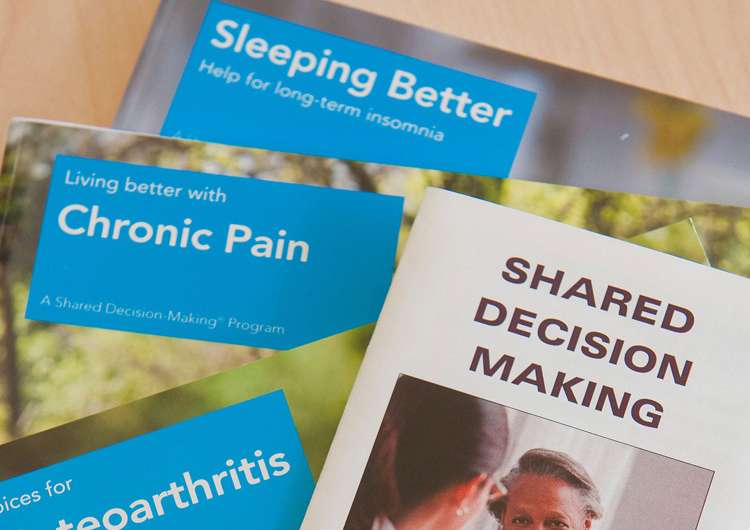Report reviews 10 years of shared decision making at Massachusetts General Hospital

The health care system has come a long way from the "doctor knows best" approach of decades ago, and the importance of involving patients in decisions about their medical care - particularly in situations when there is more than one treatment option - is broadly acknowledged. At Massachusetts General Hospital (MGH), a formal Shared Decision Making Program was instituted in 2005 to provide decision aids - booklets, videos and online resources - to patients to help them learn about their options and participate in decisions about their care.
From a pilot program in a single primary care practice, the program now includes all of the hospital's adult primary care practices and has been extended to specialty practices in orthopedics, cardiology and obstetrics/gynecology. In the April issue of the journal Health Affairs, a team from MGH and Partners HealthCare reviews the program's first decade and describes specific initiatives designed to increase the use of patient decision aids.
"Physicians often tell us that there is not enough time to do shared decision making or that their patients would rather the doctor make the decision," says Leigh Simmons, MD, medical director of the MGH Health Decision Sciences Center and a co-author of the Health Affairs report. "However, after incorporating decision aids into their practice, physicians tell us that the conversations they have with patients are at a more advanced level, and they are able to focus on the things that matter most to their patients. Often they are surprised at how engaged patients are after using a decision aid."
During the first years of the program, physicians were responsible for placing orders for decision aids through the electronic medical record. Simmons and Karen Sepucha, PhD, director of the MGH Health Decision Sciences Center and corresponding author of the current report, worked with practices to increase the integration of decision aids into routine care. Efforts included developing automatic prompts to physicians when they referred patients to specialists for low back pain and osteoarthritis and encouraging practices to use their disease registries to provide decision aids to patients newly diagnosed with diabetes.
Sepucha and Simmons soon recognized the need to develop a wider awareness of shared decision making and delivered training sessions to over 160 primary care clinicians at 15 of the hospital's 18 primary care practices. The sessions led to more than doubling the use of decision aids, and clinicians surveyed several months later reported the aids had improved the quality of patient care and changed their discussions with patients.
The clinicians also expressed interest in exploring different ways to get the decision aids to patients. This finding led to the development of a second initiative that engaged clinic staff in helping patients order the aids themselves. This new program was piloted at the hospital's community health center in Revere, Mass., which serves a working class population including many immigrants, and at an adult primary care practice based at the hospital.
Both practices found a significant increase in the numbers of orders placed when patients were given the opportunity to select topics. The orders placed by patients also gave clinicians new insight into areas of patient interest. While the decision aids most commonly ordered by physicians were for prostate cancer screening, colon cancer screening, advanced directives and insomnia; those most frequently ordered by patients covered low back pain, diabetes and anxiety, along with advanced directives and insomnia.
"The initiatives allowed patients to access the decision aids more directly, rather than relying on physicians to remember to use them," says Simmons. "There now is a big push toward more team-based care in medicine; and once we started to engage the entire team - including front desk staff, medical assistants and most crucially, the patients - we saw the use of decision aids take off."
Over the past two years, the team has worked to expand shared decision making across Partners HealthCare-affiliated hospitals and practices. The Population Health Management program at Partners aims to provide clinical programs to improve the quality of care and patients' experience, while reducing total health care spending. Adam Licurse, MD, a co-author of the Health Affairs report and associate medical director for Partners Population Health Management, explains, "The shared decision making program is a critical piece that helps ensure Partners patients receive the right care at the right time, based on their unique preferences and values."
A next step will be evaluating how successful the program has been in improving patient care. Sepucha says, "We have several research projects under way trying to find the best tools to engage patients in significant medical decisions and the best ways to train clinicians to have shared decision making conversations. We survey patients to determine whether they are well informed about their treatment options, involved in conversations and receive treatments that match their goals. Ultimately, that will help us ensure that patients receive the care that is right for them." Both Sepucha and Simmons are assistant professors of Medicine at Harvard Medical School.
More information: Health Affairs, dx.doi.org/10.1377/hlthaff.2015.1376



















